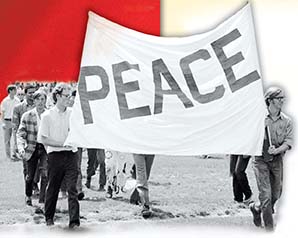SECTION 4: The War’s End and Impact

▲ Antiwar demonstrators march in Washington, D.C.

Protest button ►
WITNESS HISTORY  AUDIO
AUDIO
Antiwar Protests Spread
As Richard Nixon entered the White House in January 1969, students across the country continued to protest the war. And their words were starting to reach ordinary Americans, not just “long-haired radicals.” In late 1969, antiwar protesters organized a series of peaceful demonstrations called “moratoriums.” On October 15, the mayor of New York City addressed a crowd of these protesters:
“We cannot [accept] the charge from Washington that this peaceful protest is unpatriotic. We heard that charge five years ago and three years ago…. The fact is that this dissent is the highest form of patriotism. It is the peaceful American way to turn the nation away from a self-defeating course.”
—New York mayor John Lindsay, 1969
Objectives
- Assess Nixon’s new approach to the war, and explain why protests continued.
- Explain what led to the Paris Peace Accords and why South Vietnam eventually fell to the communists.
- Evaluate the impact of the Vietnam War on the United States.
Terms and People
- Vietnamization
- My Lai
- Pentagon Papers
- Paris Peace Accords
- War Powers Act
NoteTaking
Reading Skill: Compare and Contrast Note the similarities and differences between Nixon’s Vietnam policy and that of Lyndon Johnson.
Why It Matters As a presidential candidate, Richard Nixon promised “peace with honor” and an end to a war that had fractured American society. Nixon did indeed withdraw American troops, and the Vietnam War finally ended. But the impact of the war endured. As the nation recovered from war, Americans reexamined the struggle against communism, the power of the presidency, and America’s role in the world. Section Focus Question: How did the Vietnam War end, and what were its lasting effects?
Nixon Starts the Pullout
Nixon’s defenders argued that he was a hard-working patriot with a new vision for America. His critics charged that he was a deceitful politician bent on acquiring power and punishing his enemies. There were elements of truth to both views. But defenders and critics alike agreed that Richard Nixon was a determined man with abundant political talent. From his first day in office, the new President realized that ending the Vietnam War was the key to everything else he hoped to achieve.
Peace Talks Stall
Though formal peace talks between the warring parties had begun in May 1968, they were bogged down from the outset by disagreements and a lack of compromise. When Richard Nixon took office in January 1969, his peace delegation firmly believed they could break the impasse. The Americans and South Vietnamese wanted all communist troops out of South Vietnam.





